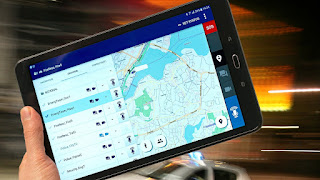The 3rd Generation Partnership Project’s pursuit of a complete mission-critical standard solution moves on: a plug test in the US in June 2018 will verify the latest results
Dubai, UAE- 17 April 2018 – Airbus will intensively contribute to the next steps in finding a global standard for mission-critical multimedia group communication. After the 3rd Generation Partnership Project’s (3GPP) completion of release 14 of secure multimedia group communication in December 2017, Airbus and its partners within 3GPP are now working on release 15 and 16 by the end of 2019. 3GPP is a global initiative that unites various standard development organisations and sets international telecommunications standards as well as system specifications.
One of the prime intentions is to improve real-time video group communication (MCVideo) and develop a thorough 5G solution. “It is all about verifying the current developments and test transparently the interfaces between our solutions and those of our partners in the 3GPP. We are expecting that the outcome evolves powerfully and will be confirmed in tests in June 2018 and in 2019,” says Eric Davalo, Head of Strategic Development for Secure Land Communications at Airbus.
One of the areas Airbus will closely look at during the plug test in June 2018 is how its application Tactilon Agnet will work with Mission-Critical Push to Talk and Mission-Critical Data solutions (the safe transmission of messages, pictures and videos, but not in real-time). These solutions equally comply with the 3GPP releases 13 and 14 standard definitions. Both mission-critical functions refer to a functionality which allows immediate availability for group and one-to-one communication.
However, the definition of the Mission-Critical Video will still require further improvements with the release 15, before it can be intensively tested. Furthermore, the application’s hybrid use in Tetra and broadband networks will also be under scrutiny to find the best standard.
“Next June we will take part in an international plug test in Disaster City in Texas, United States, where we will check collaboratively the next level of standard developments with other companies,” says Eric Davalo. “Afterwards, we will be focusing on mission-critical video group communication and start considering the 5G networks which evolve naturally out of the existing 4G technology. Our ideas look really promising.”
"إيرباص" تسهم في وضع الحلول المعيارية لشبكات الجيل الخامس
"مشروع شراكة الجيل الثالث" يهدف إلى إيجاد حل معياري متكامل لاتصالات الأزمات والطوارئ
اختبار للتجهيزات سيجري في الولايات المتحدة في شهر يونيو للتحقق من صحة أحدث النتائج
دبي، الإمارات العربية المتحدة - في 17 ابريل 2018: أعلنت "إيرباص" عن عزمها المساهمة بشكل مكثف في المساعي الجارية لإيجاد معيار عالمي للاتصالات الجماعية متعددة الوسائط في حالات الأزمات والطوارئ. وبعد أن تم الانتهاء من الإصدار 14 من مشروع شراكة الجيل الثالث (3GPP) والخاص بالاتصالات الجماعية الآمنة متعددة الوسائط في 17 ديسمبر الماضي، تعمل "إيرباص" وشركائها في مشروع شراكة الجيل الثالث حالياً على وضع الإصدارين 15 و16 بحلول نهاية العام المقبل. ويعد مشروع شراكة الجيل الثالث مبادرة عالمية تجمع مختلف المؤسسات المعنية بتطوير معايير الاتصالات، وتقوم بوضع المعايير الدولية للاتصالات السلكية واللاسلكية، بالإضافة إلى مواصفات أنظمة الاتصال.
ومن بين أهم الأهداف المنشودة هو تحسين جودة الاتصالات الجماعية عبر الفيديو في الوقت الحقيقي (MCVideo) وتطوير حل شامل لشبكات الجيل الخامس. وفي هذا السياق، قال إيرك دافالو، رئيس قسم التطوير الاستراتيجي في سكيور لاند كوميونيكيشن لدى "إيرباص": "يتعلق الأمر بالتحقق من التطورات الحالية واجراء اختبار شفاف لأجهزة الربط بين حلولنا والحلول الأخرى الخاصة بشركائنا في مشروع شراكة الجيل الثالث، حيث نتوقع أن تكون النتائج قوية وأن يتم تأكيدها خلال الاختبارات التي ستجرى في شهر يونيو المقبل والعام القادم."
وستحرص "إيرباص" خلال اختبارات الأجهزة التي ستجري في يونيو المقبل على رؤية كيفية عمل تطبيقها "تاكتيلون آغنت" (Tactilon Agnet) مع حلول بيانات الأزمات والطوارئ وتقنية الاتصال "اضغط لتتحدث" في حالات الأزمات والطوارئ (من حيث النقل الآمن للرسائل والصور ومقاطع الفيديو، لكن ليس في الزمن الحقيقي). وتتوافق هذه الحلول مع تعريفات المعايير في الاصدارين 13 و14 من مشروع شراكة الجيل الثالث، وكلاهما يشيران إلى الدور الذي يسمح بالتوافر الفوري للاتصالات الجماعية وكذلك الاتصالات من شخص لآخر.
ويبقى تعريف تقنية اتصالات الأزمات والطوارئ عبر الفيديو بحاجة إلى مزيد من التحسينات في الإصدار الخامس، قبل أن يتم اختبارها بشكل مكثف. وبالإضافة إلى ذلك، فإن الاستخدام الهجين للتطبيق في شبكات "تترا" والنطاق العريض، سيكون أيضاً تحت الاختبار من أجل إيجاد أفضل المعايير.
وأضاف دافالو: "سنشارك في شهر يونيو المقبل في اختبار دولي للأجهزة في "ديزاستر سيتي" (Disaster City) في ولاية تكساس في الولايات المتحدة الأمريكية، حيث سنتحقق من المستوى التالي للمعايير مع الشركات الأخرى. وسنركز بعد ذلك على الاتصالات الجماعية بالفيديو في حالات الأزمات والطوارئ، ومن ثم البدء بمناقشة شبكات الجيل الخامس التي يتم تطويرها بالاستناد إلى تقنية الجيل الرابع، حيث تبدو أفكارنا واعدة في هذا الإطار."

